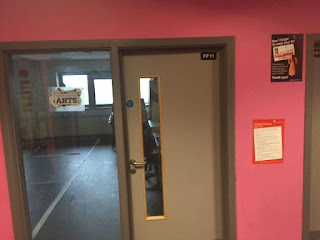Wednesday, 16 December 2015
Minor issue with editing
As we were ready to start editing we discovered that we had to decompress all of the video files. This is because the files would become 'glitchy' and harder to edit if left at the recorded resolution. We can use this to our advantage as we now know that we have to compress the files before we are able to edit and it will save us time in the final coursework.
Thursday, 10 December 2015
Pre-production planning
Our group has finally completed all the pre production stages. This includes us exchanging phone numbers and making a group chat with the 4 of us in. We also organised when we could meet outside of teaching periods with one or two others in the group to organise the blog or deciding where to film. We also organised the time and place we will be filming. (see previous post). We also decided who is responsible for certain parts of the filming. For example I (Max) am in charge of props and costume, while Tony is in charge of mise en scene and filming in general.
We have organised all the filming equipment so we will have it at time of recording. Finally we have also conducted a risk assessment for our shooting location(s) and is also recorded on our blog under risk assessment.
Story board of the story
Callum and I (Max) were the ones to create this story board. Callum was the artist of the first 17 shots and was the one who thought of some great shots and story ideas. This is while I was writing the script and story and drew the last 7 shots. We decided to create a < 1 minute sequence about a drug lord and a small time criminal arguing about a deal gone wrong. Then a short ending gun fight kicks off. On the end shot there is guns aimed at both drug lord and the criminal, a gun shot goes off and the screen goes black. Meaning that no one knows the out come of the gunfight. We have planned to have the sequence take 57 seconds over all.
In the story boarding there are two actors as bodyguards however when we were creating it we had another actor who is now unable to attend to the filming. This now means that we only have one bodyguard, the drug lord and the criminal.
Monday, 7 December 2015
LOCATION OF FILMING
The room we are filming in needs to have windows, big open area and easy to set up the scene in. The room we have chosen is F11 for all these reasons.

Risk assessment
We chose to have a wide open space to be able to get good any angle or shot size we want too, however this is also because it lowers the amount of risks to the actors and camera workers. The wide area means there is nothing you can trip on. The only area of the room that really has the issue of being able to trip up is the right side of the room from the door. This means we will try avoid this area as it could be an issue for the camera men focusing on the filming and not where they are going.
Again about this wall there is expensive and fairly fragile equipment such as PC's, electronic whiteboards and monitors. This means we will avoid this area for safety of our selves and the equipment.
As of writing this we have not started filming but we will start very shortly.
The room F11:
Thursday, 3 December 2015
Props & costume, made and used
With props we all contributed towards them. cardboard boxes and brown tape, a paintball gun and a paintball mask - Jake , Max - glasses and guns , Tony - BB gun.
When coming up for ideas, each person contributed to the bringing in of props. Some however were from the performing arts prop room. We obtained a weapon and a mask from the prop room but,
Match on action
Match on action refers to film and video editing techniques where the editor cuts from
one shot to another view that matches
the first shot's action. A
common example is a women walking up to a door and reaching for the door knob.
This creates a sense of continuity as the
action continuing through the scene creating a visual bridge drawing the
viewers’ attention away from cutting and continuity issues.
A variant of match on action is a cut in which the
subject exits the frame in the first shot and then enters the frame in the
subsequent shot. The entrance in the second shot must match the screen
direction and motive rhythm of the exit in the first shot.
An example of match on action:
The 180˚
rule: This rule states that
all cameras must be filmed on one side of an imaginary line so it does not
break continuity. If the rule is broken, the audience will be confused and may
lose focus subsequently missing vital parts of the film, especially in scenes
such as conversations, chases or sport. The rule must never be broken unless it
is for effect, an example of this being in Stanley Kubrick’s ‘The Shining’,
where the roles of each character are reversed, making the accused the accuser.
The only other way that the line can be crossed without confusing the audience
is by showing camera movement, therefore meaning that the camera has to stay on
that side of the line unless camera movement is shown crossing back over the
line.
Link to Youtube video
Subscribe to:
Comments (Atom)








